【ESP32S3 Sense接入百度在线语音识别】
视频地址:
ESP32S3 Sense接入百度在线语音识别
1. 前言

使用Seeed XIAO ESP32S3 Sense开发板接入百度智能云实现在线语音识别。自带麦克风模块用做语音输入,通过串口发送字符“1”来控制数据的采集和上传。
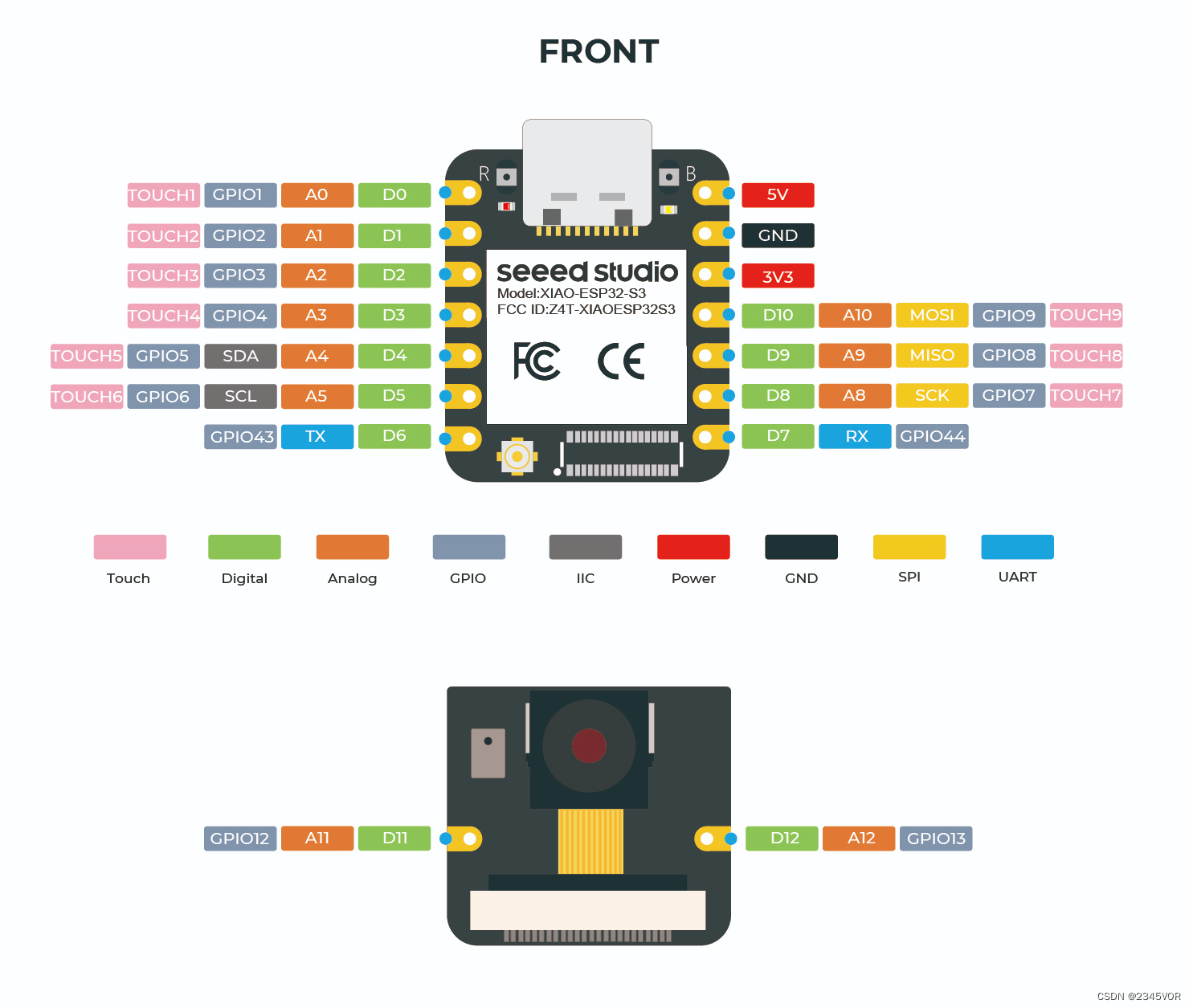
步骤概括
(1) 在百度云控制端选择“语音识别”并创建应用获取API Key和Secret Key获取token
(2)采集音频数据,将数据打包成规定的格式,POST发送到请求API
(3) 接收返回的识别数据
2. 操作流程
2.1 创建语音识别应用
登录百度云账号,选择语音识别
官网地址:https://ai.baidu.com/tech/speech

新用户可以直接领取资源,也可付费接入,创建应用。
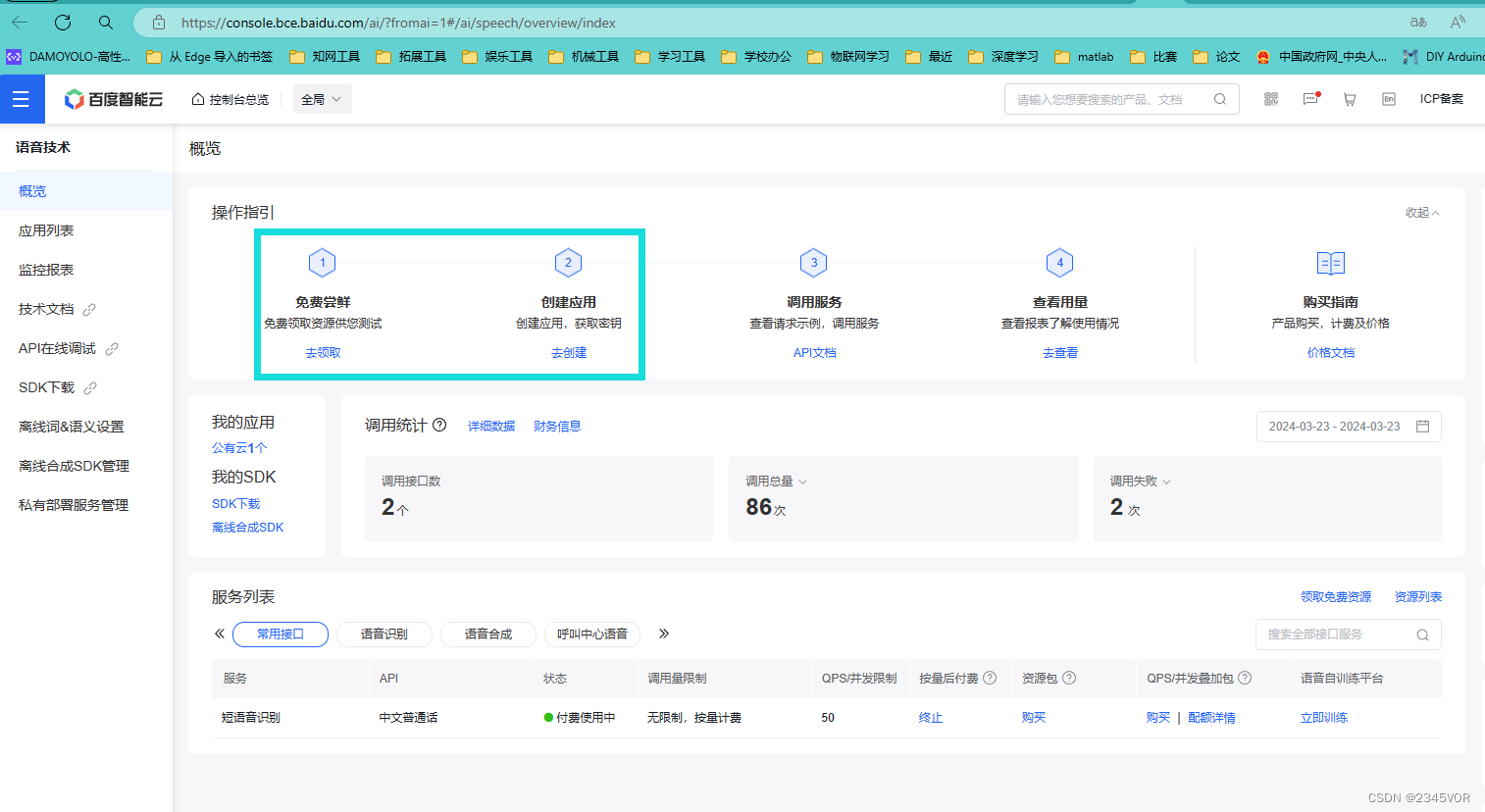
根据创建应用生成的API Key和Secret Key来获取token,创建好应用,点管理应用,会有API Key和Secret Key,如下图应用创建成功

2.2 API秘钥创建
点击在线调试
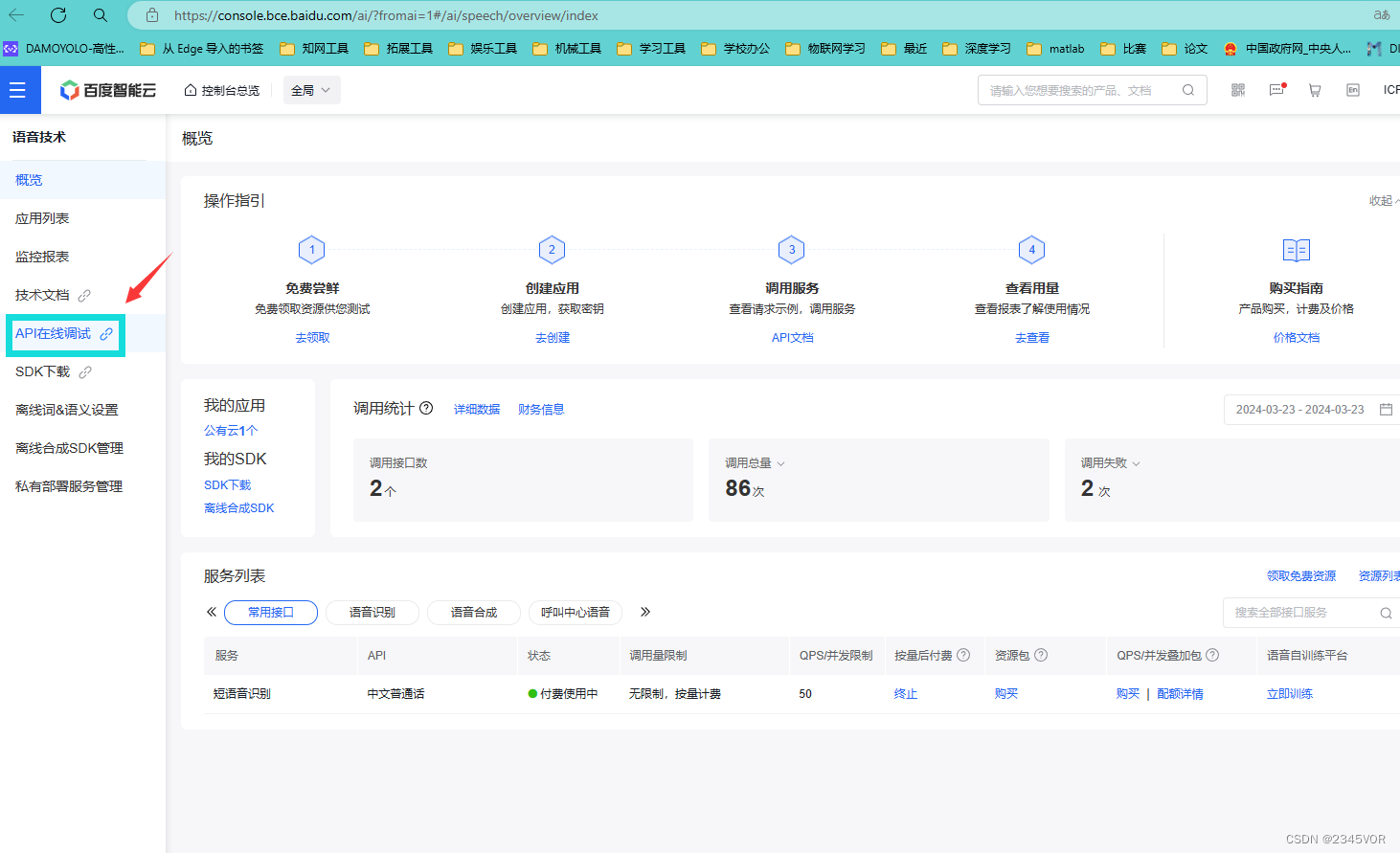
按照如下顺序选择
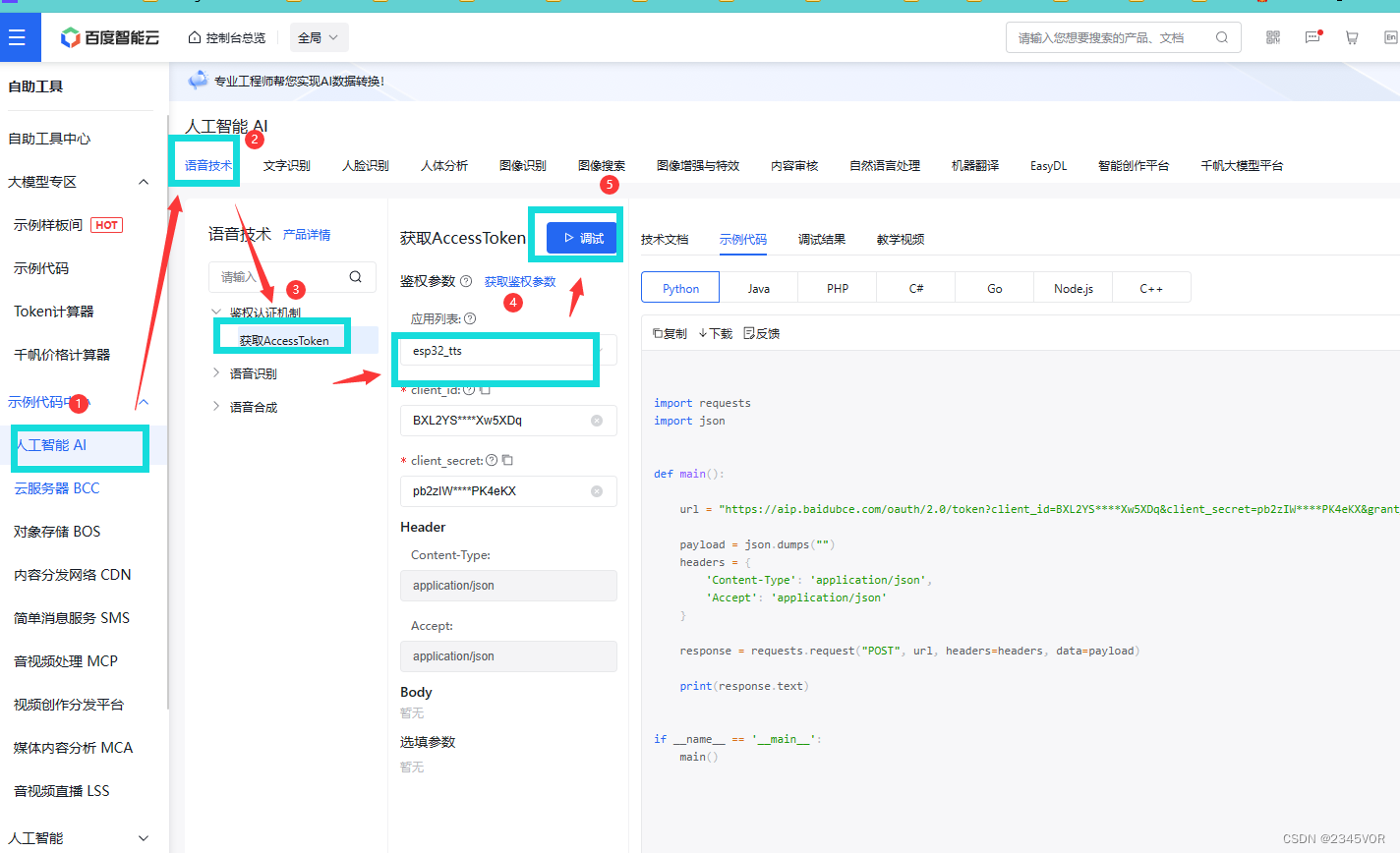
有了API Key和Secret Key就可以得到token,下面附上ESP32进行get请求得到token的代码
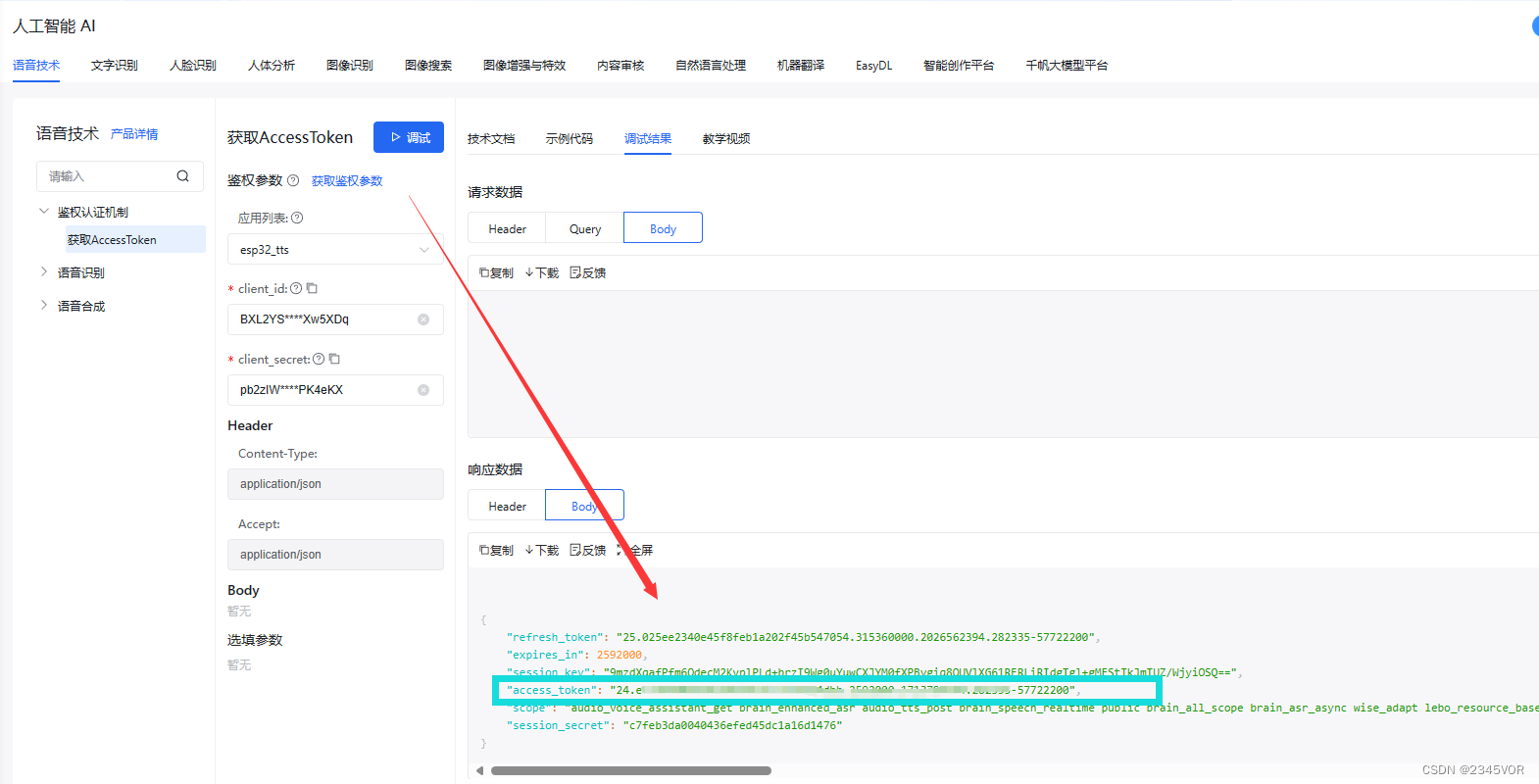
access_token对应的值就是可用的token了,每次申请的token有效期为30天,过期需要重新申请,可以申请多个。不用每次都调用获取token的程序,申请一个可以用30天,定时更新就可以吧。
3. JSON语音接入
采集数据,POST发送到请求API数据上传 POST 方式有 2 种:JSON 格式和RAW 格式。
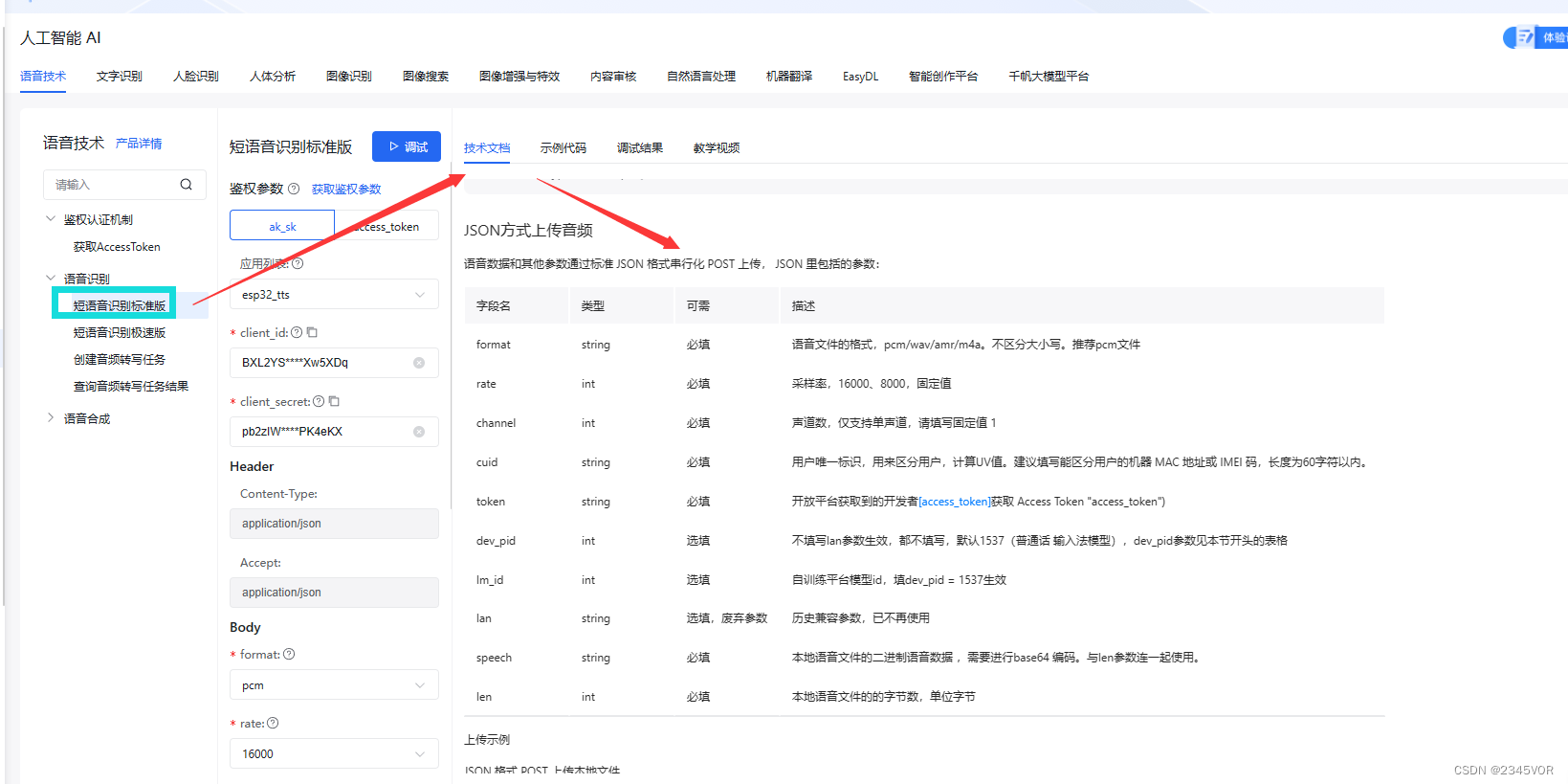
3.1 JSON格式
这里介绍使用使用JSON格式上传的方式,下图为JSON格式上传的一些必要的参数说明
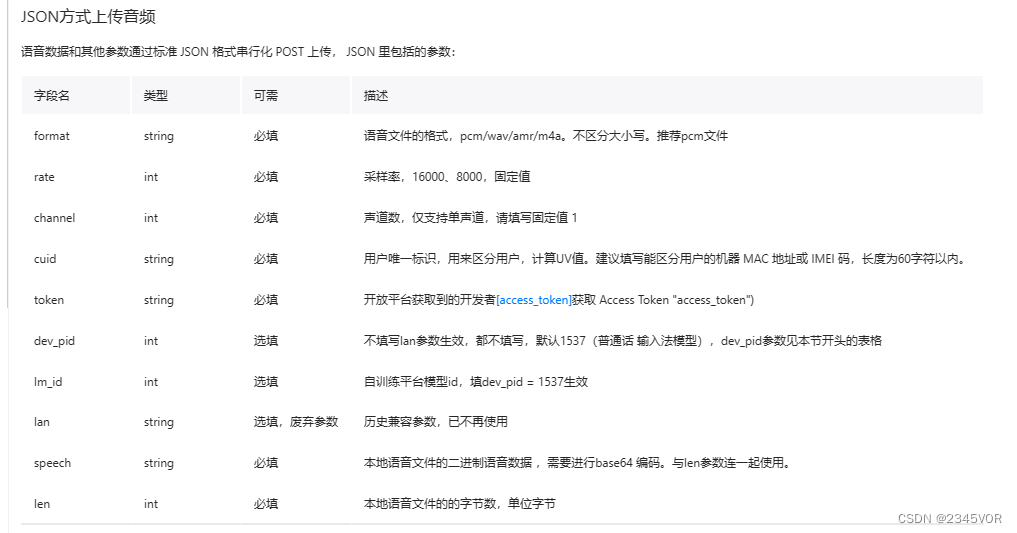
3.2 ESP32S3 Sense接入代码
图中对数据类型和内容说的很明确了,只需要按照这个格式打包好数据然后发送就行,下面是ESP32的具体实现代码。
#include <Arduino.h>
#include "base64.h"
#include "WiFi.h"
#include "HTTPClient.h"
#include "cJSON.h"
#include <I2S.h>
#include <ArduinoJson.h>
// #define key 4 //端口0
// #define ADC 2 //端口39
// #define led 15 //端口2
const int buttonPin = 1; // the number of the pushbutton pin
const int ledPin = 21; // the number of the LED pin
HTTPClient http_client;
// 1. Replace with your network credentials
const char* ssid = "J09 502";
const char* password = "qwertyuiop111";
hw_timer_t* timer = NULL;
#define data_len 16000
uint16_t adc_data[data_len]; //16000个数据,8K采样率,即2秒,录音时间为2秒,想要实现更长时间的语音识别,就要改这个数组大小
//和下面data_json数组的大小,改大一些。
uint8_t adc_start_flag = 0; //开始标志
uint8_t adc_complete_flag = 0; //完成标志
char data_json[45000]; //用于储存json格式的数据,大一点,JSON编码后数据字节数变成原来的4/3,所以得计算好,避免出现越界
void IRAM_ATTR onTimer();
void gain_token(void);
void setup() {
//Serial.begin(921600);
Serial.begin(115200);
// pinMode(ADC, ANALOG);
// pinMode(buttonPin, INPUT_PULLUP);
pinMode(ledPin, OUTPUT);
// start I2S at 16 kHz with 16-bits per sample
I2S.setAllPins(-1, 42, 41, -1, -1);
if (!I2S.begin(PDM_MONO_MODE, 16000, 16)) {
Serial.println("Failed to initialize I2S!");
while (1)
; // do nothing
}
uint8_t count = 0;
WiFi.mode(WIFI_STA);
WiFi.begin(ssid, password);
while (WiFi.status() != WL_CONNECTED) {
Serial.print(".");
count++;
if (count >= 75) {
Serial.printf("\r\n-- wifi connect fail! --");
break;
}
vTaskDelay(200);
}
Serial.printf("\r\n-- wifi connect success! --\r\n");
// gain_token();
timer = timerBegin(0, 80, true); // 80M的时钟 80分频 1M
timerAlarmWrite(timer, 125, true); // 1M 计125个数进中断 8K
timerAttachInterrupt(timer, &onTimer, true);
timerAlarmEnable(timer);
timerStop(timer); //先暂停
}
uint32_t time1, time2;
void loop() {
if (Serial.available() > 0) //按键按下
{
if (Serial.read() == '1') {
Serial.printf("Start recognition\r\n\r\n");
digitalWrite(ledPin, HIGH);
adc_start_flag = 1;
timerStart(timer);
// time1=micros();
while (!adc_complete_flag) //等待采集完成
{
ets_delay_us(10);
}
// time2=micros()-time1;
timerStop(timer);
adc_complete_flag = 0; //清标志
digitalWrite(ledPin, LOW);
// Serial.printf("time:%d\r\n",time2); //打印花费时间
memset(data_json, '\0', strlen(data_json)); //将数组清空
strcat(data_json, "{");
strcat(data_json, "\"format\":\"pcm\",");
strcat(data_json, "\"rate\":16000,"); //采样率 如果采样率改变了,记得修改该值,只有16000、8000两个固定采样率
strcat(data_json, "\"dev_pid\":1537,"); //中文普通话
strcat(data_json, "\"channel\":1,"); //单声道
strcat(data_json, "\"cuid\":\"666666\","); //识别码 随便打几个字符,但最好唯一
strcat(data_json, "\"token\":\"24.8f6133335e191.2592000.1713789066.282335-57722200\","); //token这里需要修改成自己申请到的token
strcat(data_json, "\"len\":32000,"); //数据长度 如果传输的数据长度改变了,记得修改该值,该值是ADC采集的数据字节数,不是base64编码后的长度
strcat(data_json, "\"speech\":\"");
strcat(data_json, base64::encode((uint8_t*)adc_data, sizeof(adc_data)).c_str()); //base64编码数据
strcat(data_json, "\"");
strcat(data_json, "}");
// Serial.println(data_json);
int httpCode;
http_client.setTimeout(5000);
http_client.begin("http://vop.baidu.com/server_api"); //https://vop.baidu.com/pro_api
http_client.addHeader("Content-Type", "application/json");
httpCode = http_client.POST(data_json);
if (httpCode == 200) {
if (httpCode == HTTP_CODE_OK) {
String response = http_client.getString();
http_client.end();
Serial.println(response);
// Parse JSON response
DynamicJsonDocument jsonDoc(512);
deserializeJson(jsonDoc, response);
String outputText = jsonDoc["result"][0];
// 访问"result"数组,并获取其第一个元
// 输出结果
Serial.println(outputText);
} else {
Serial.printf("[HTTP] GET... failed, error: %s\n", http_client.errorToString(httpCode).c_str());
}
}
// while (!digitalRead(buttonPin))
// ;
Serial.printf("Recognition complete\r\n");
}
}
vTaskDelay(1);
}
uint32_t num = 0;
portMUX_TYPE timerMux = portMUX_INITIALIZER_UNLOCKED;
void IRAM_ATTR onTimer() {
// Increment the counter and set the time of ISR
portENTER_CRITICAL_ISR(&timerMux);
if (adc_start_flag == 1) {
//Serial.println("");
// adc_data[num] = analogRead(ADC);
adc_data[num] = I2S.read();
num++;
if (num >= data_len) {
adc_complete_flag = 1;
adc_start_flag = 0;
num = 0;
//Serial.println(Complete_flag);
}
}
portEXIT_CRITICAL_ISR(&timerMux);
}
// void gain_token(void) //获取token
// {
// int httpCode;
// //注意,要把下面网址中的your_apikey和your_secretkey替换成自己的API Key和Secret Key
// http_client.begin("https://aip.baidubce.com/oauth/2.0/token?grant_type=client_credentials&client_id=your_apikey&client_secret=your_secretkey");
// httpCode = http_client.GET();
// if (httpCode > 0) {
// if (httpCode == HTTP_CODE_OK) {
// String payload = http_client.getString();
// Serial.println(payload);
// }
// } else {
// Serial.printf("[HTTP] GET... failed, error: %s\n", http_client.errorToString(httpCode).c_str());
// }
// http_client.end();
// }
3.3 ESP32接入代码
使用ESP32接入百度智能云实现在线语音识别,max9814麦克风模块用做语音输入,一个按键来控制数据的采集和上传
#include <Arduino.h>
#include "base64.h"
#include "WiFi.h"
#include "HTTPClient.h"
#include "cJSON.h"
#define key 4 //端口0
#define ADC 2 //端口39
#define led 15 //端口2
HTTPClient http_client;
hw_timer_t * timer = NULL;
#define data_len 16000
uint16_t adc_data[data_len]; //16000个数据,8K采样率,即2秒,录音时间为2秒,想要实现更长时间的语音识别,就要改这个数组大小
//和下面data_json数组的大小,改大一些。
uint8_t adc_start_flag=0; //开始标志
uint8_t adc_complete_flag=0; //完成标志
char data_json[45000]; //用于储存json格式的数据,大一点,JSON编码后数据字节数变成原来的4/3,所以得计算好,避免出现越界
void IRAM_ATTR onTimer();
void gain_token(void);
void setup() {
//Serial.begin(921600);
Serial.begin(115200);
pinMode(ADC,ANALOG);
pinMode(key,INPUT_PULLUP);
pinMode(led,OUTPUT);
uint8_t count=0;
WiFi.disconnect(true);
WiFi.begin("1111110","88888888");//填写自己的wifi账号密码
while (WiFi.status() != WL_CONNECTED)
{
Serial.print(".");
count++;
if(count>=75){
Serial.printf("\r\n-- wifi connect fail! --");
break;
}
vTaskDelay(200);
}
Serial.printf("\r\n-- wifi connect success! --\r\n");
// gain_token();
timer = timerBegin(0, 80, true); // 80M的时钟 80分频 1M
timerAlarmWrite(timer, 125, true); // 1M 计125个数进中断 8K
timerAttachInterrupt(timer, &onTimer, true);
timerAlarmEnable(timer);
timerStop(timer); //先暂停
}
uint32_t time1,time2;
void loop() {
if(digitalRead(key)==0) //按键按下
{
Serial.printf("Start recognition\r\n\r\n");
digitalWrite(led,HIGH);
adc_start_flag=1;
timerStart(timer);
// time1=micros();
while(!adc_complete_flag) //等待采集完成
{
ets_delay_us(10);
}
// time2=micros()-time1;
timerStop(timer);
adc_complete_flag=0; //清标志
digitalWrite(led,LOW);
// Serial.printf("time:%d\r\n",time2); //打印花费时间
memset(data_json,'\0',strlen(data_json)); //将数组清空
strcat(data_json,"{");
strcat(data_json,"\"format\":\"pcm\",");
strcat(data_json,"\"rate\":8000,"); //采样率 如果采样率改变了,记得修改该值,只有16000、8000两个固定采样率
strcat(data_json,"\"dev_pid\":1537,"); //中文普通话
strcat(data_json,"\"channel\":1,"); //单声道
strcat(data_json,"\"cuid\":\"666666\","); //识别码 随便打几个字符,但最好唯一
strcat(data_json,"\"token\":\"24.c640024cd1355e\","); //token这里需要修改成自己申请到的token
strcat(data_json,"\"len\":32000,"); //数据长度 如果传输的数据长度改变了,记得修改该值,该值是ADC采集的数据字节数,不是base64编码后的长度
strcat(data_json,"\"speech\":\"");
strcat(data_json,base64::encode((uint8_t *)adc_data,sizeof(adc_data)).c_str()); //base64编码数据
strcat(data_json,"\"");
strcat(data_json,"}");
// Serial.println(data_json);
int httpCode;
http_client.begin("http://vop.baidu.com/server_api"); //https://vop.baidu.com/pro_api
http_client.addHeader("Content-Type","application/json");
httpCode = http_client.POST(data_json);
if(httpCode == 200) {
if(httpCode == HTTP_CODE_OK) {
String payload = http_client.getString();
Serial.println(payload);
}
}
else {
Serial.printf("[HTTP] GET... failed, error: %s\n", http_client.errorToString(httpCode).c_str());
}
http_client.end();
while (!digitalRead(key));
Serial.printf("Recognition complete\r\n");
}
}
uint32_t num=0;
portMUX_TYPE timerMux = portMUX_INITIALIZER_UNLOCKED;
void IRAM_ATTR onTimer(){
// Increment the counter and set the time of ISR
portENTER_CRITICAL_ISR(&timerMux);
if(adc_start_flag==1)
{
//Serial.println("");
adc_data[num]=analogRead(ADC);
num++;
if(num>=data_len)
{
adc_complete_flag=1;
adc_start_flag=0;
num=0;
//Serial.println(Complete_flag);
}
}
portEXIT_CRITICAL_ISR(&timerMux);
}
void gain_token(void) //获取token
{
int httpCode;
//注意,要把下面网址中的your_apikey和your_secretkey替换成自己的API Key和Secret Key
http_client.begin("https://aip.baidubce.com/oauth/2.0/token?grant_type=client_credentials&client_id=your_apikey&client_secret=your_secretkey");
httpCode = http_client.GET();
if(httpCode > 0) {
if(httpCode == HTTP_CODE_OK) {
String payload = http_client.getString();
Serial.println(payload);
}
}
else {
Serial.printf("[HTTP] GET... failed, error: %s\n", http_client.errorToString(httpCode).c_str());
}
http_client.end();
}
上面代码是将数据拼接成要求的JSON的格式并通过POST的方式发送到请求API,并接收打印返回的数据消息。使用的定时器设置成8K频率定时采集音频数据,上面代码中并未展示,后面会附上完整代码。
ESP32是有JSON库的,在 “cJSON.h” 头文件中,但是我没有用,因为我发现数据太长时不知道为啥会出现莫名其妙的错误,也没深究,就使用函数strcat()将数据拼接成规定的格式,好使,就是写的时候麻烦一些,但问题不大。
POST发送数据有一个固定头部:Content-Type:application/json,POST前需要设置一下。
4. 接收数据
参考以下烧录配置,
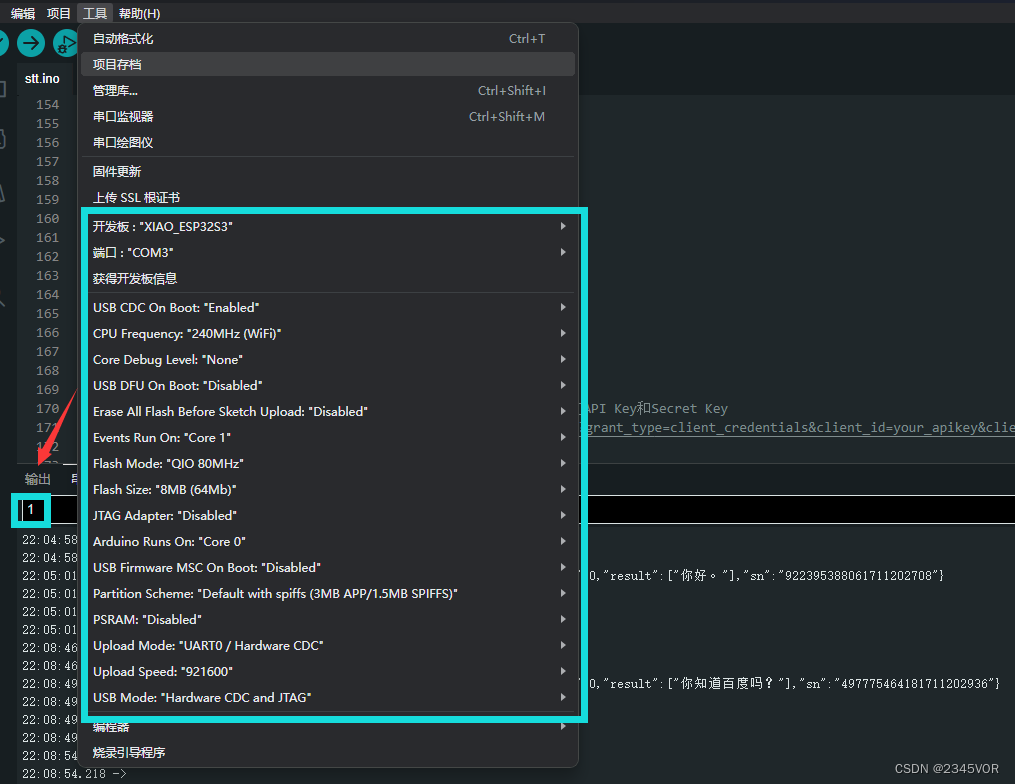
串口输入字符“1”,点击按回车键,然后有2s录音时间。等待百度在线语音识别返回,在上一步的代码中实现了接收数据,这里列一下返回的数据。
22:04:58.854 -> Start recognition
22:04:58.854 ->
22:05:01.558 -> {"corpus_no":"7349559668823131804","err_msg":"success.","err_no":0,"result":["你好。"],"sn":"922395388061711202708"}
22:05:01.558 ->
22:05:01.558 -> 你好。
22:05:01.558 -> Recognition complete
22:08:46.838 -> Start recognition
22:08:46.838 ->
22:08:49.809 -> {"corpus_no":"7349560648200206506","err_msg":"success.","err_no":0,"result":["你知道百度吗?"],"sn":"497775464181711202936"}
22:08:49.809 ->
22:08:49.809 -> 你知道百度吗?
22:08:49.809 -> Recognition complete
22:08:54.218 -> Start recognition
22:08:54.218 ->
22:08:57.084 -> {"corpus_no":"7349560678205790969","err_msg":"success.","err_no":0,"result":["我喜欢小黄人。"],"sn":"748488478211711202943"}
22:08:57.084 ->
22:08:57.084 -> 我喜欢小黄人。
22:08:57.084 -> Recognition complete
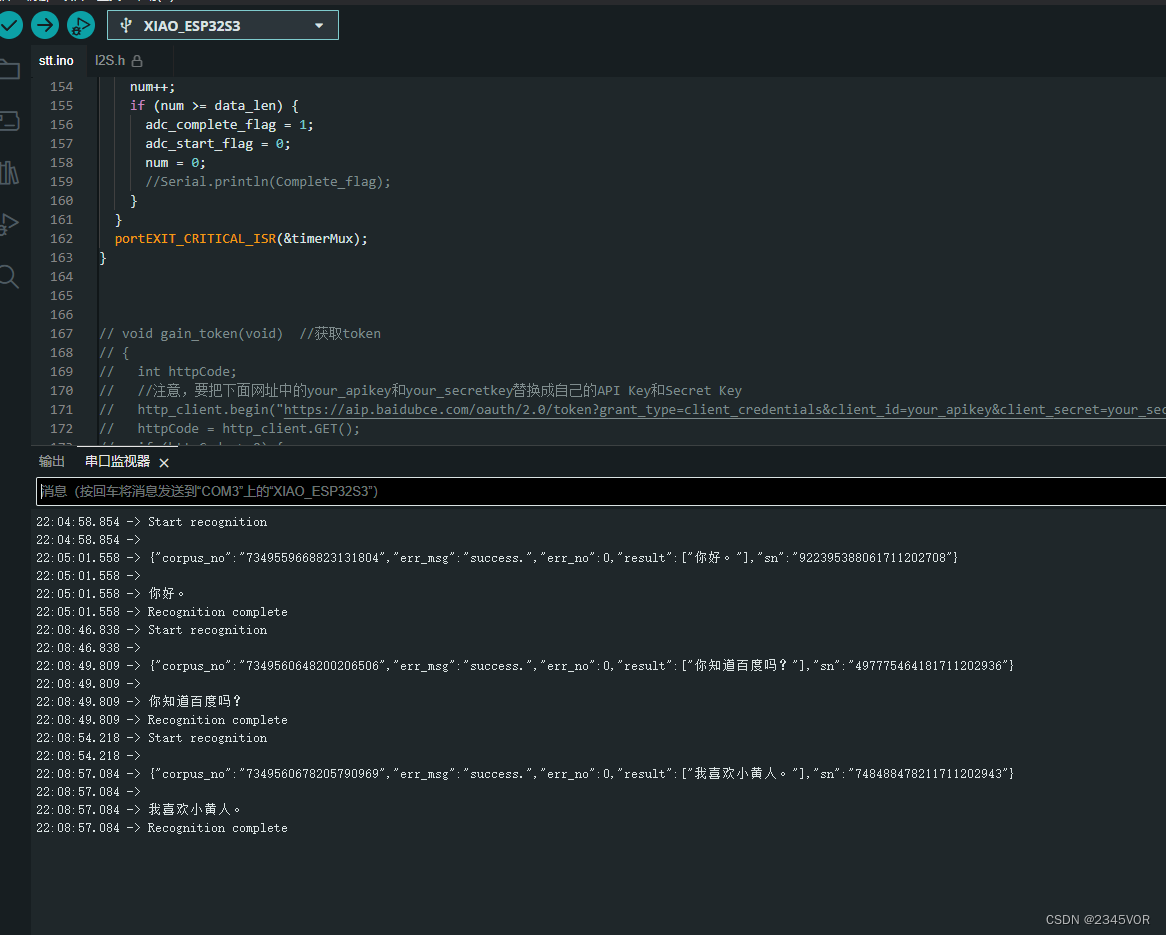
数据发送成功则会返回正确的识别数据,当然声音信号不好时返回的语音识别也会不准确。
5. 总结
本文使用Seeed XIAO ESP32S3 Sense开发板接入百度智能云实现在线语音识别。自带麦克风模块用做语音输入,通过串口发送字符“1”来控制数据的采集和上传。从而实现对外部世界进行感知,充分认识这个有机与无机的环境,科学地合理地进行创作和发挥效益,然后为人类社会发展贡献一点微薄之力。🤣🤣🤣
- 我会持续更新对应专栏博客,非常期待你的三连!!!🎉🎉🎉
- 如果鹏鹏有哪里说的不妥,还请大佬多多评论指教!!!👍👍👍
- 下面有我的🐧🐧🐧群推广,欢迎志同道合的朋友们加入,期待与你的思维碰撞😘😘😘
参考文献:ESP32接入百度智能云语音识别,实现在线语音识别
原文地址:https://blog.csdn.net/vor234/article/details/136975580
免责声明:本站文章内容转载自网络资源,如本站内容侵犯了原著者的合法权益,可联系本站删除。更多内容请关注自学内容网(zxcms.com)!
